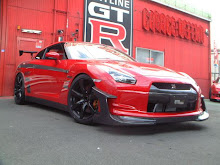
History
Many attribute the return of drifting as a competitive sport to mountain-road racers of rural Japan. Informal challenges on back mountain roads (called touge (峠), pronounced "toh-ge") eventually evolved into a heavily funded and advertised competitive events, sanctioned by organizations and held on private tracks.
Drifting started out as a racing technique popular in the All Japan Touring Car Championship races over 30 years ago. A motorcycling legend turned driver named Kunimitsu Takahashi was the foremost practitioner of drifting techniques in the 1970's. Takahashi's aggressive drifting skills — he was famous for hitting the apex (the point where the car is closest to the inside of a turn) at high speed and then drifting through the corner, preserving a high rate of speed — earned him several championships and a legion of fans who enjoyed the spectacle of burning tires and perilous speed.
A street racer named Keiichi Tsuchiya became particularly enthralled by Takahashi's drift techniques. Tsuchiya began practicing his drifting skills on the streets, and quickly gained a reputation amongst the "hashiriya" or racing crowd. In 1977, several popular car magazines and tuning garages conspired to produce a video of Tsuchiya's drifting skills on windy mountain roads. The video, called Pluspy, became a cult hit and inspired many of the professional drifting drivers on the circuits today. Tsuchiya earned himself the nickname "Dorikin," which means Drift King in Japanese. In 1977 Keiichi began his racing career driving many different cars in amateur racing series events. Racing these underpowered cars was difficult but again a great learning experience. Later Keiichi was picked up to drive the ADVAN sponsored Toyota AE86 Sprinter Trueno (JDM Corolla GT-S). During many races on a downhill corner he would drift the car and carry a better corner speed than his competitors. This technique is what made him the Drift King, not, as most believe, that he was first in the drift scene. In 1988, alongside Option magazine founder Daijiro Inada, he would help to organise one of the first drift events, the event was a sucess despite very few drivers were capable of drifting then.
Drifting "officially" began in the United States in 1996 with an event at Willow Springs racetrack in California hosted by the magazine Option, but it did not become popular until around 2002, and has since exploded into a massively popular form of motorsport. Japanese drifters are still considered to be at the cutting edge of technique and car development, but their American counterparts are quickly catching up. Many American enthusiasts consider drifting to be an extension of American motorsports such as dirt track racing, however "drifting" in its modern form as a sport unto itself is of Japanese origin.
Many of the techniques used today in drifting were developed by rally drivers competing on dirt, gravel and snow. On such surfaces, the fastest way to take a corner is generally by sliding.

Today
Nowadays, drifting has evolved into a competitive sport where drivers compete in rear-wheel drive cars to keep their cars sideways as long as possible. At the top levels of competition, especially the D1 Grand Prix from Japan and others in Australia, the Republic of Ireland, the United Kingdom, and the United States, drivers are able to keep their cars sliding for extended periods of time, often through several turns. Drifting competitions are judged based not on the time it takes to complete a course, but on line, angle, speed, and show factor. Line involves taking the correct line, which is usually announced by judges. Angle is the angle of a car in a drift, the more the better. Speed is the speed entering a turn, the speed through a turn, and the speed exiting the turn; faster is better. The show factor is based on multiple things, such as the amount of smoke, how close the car is from the wall, and falling aero. It is based on how "cool" everything looks. Final rounds of competition often include tandem drift runs nicknamed tsuiso (chase-run) in Japanese, where one car follows another through the course, attempting to keep up with or even pass the car in front. In the tsuiso rounds, it does not matter if the racing line is wrong; it matters who has the most exciting drift. Normally, the leading car usually produces a max-angle, but still close off the inside a little to prevent passing. The chasing car usually drifts with less angle, but very close to the lead car. But a car does not even have to keep up, and in fact in some cases a car that was left behind on the straight produces a beautiful drift, winning him that round. A spin, understeer, or collision results in a disqualification of the offending party.
To make judging less ambiguous, the DriftBox has been introduced, which uses GPS to measure the angle, speed and g-force during a run. This takes out the guessing element when it comes to judging the angle and speed of the drift.






















0 comments:
Post a Comment